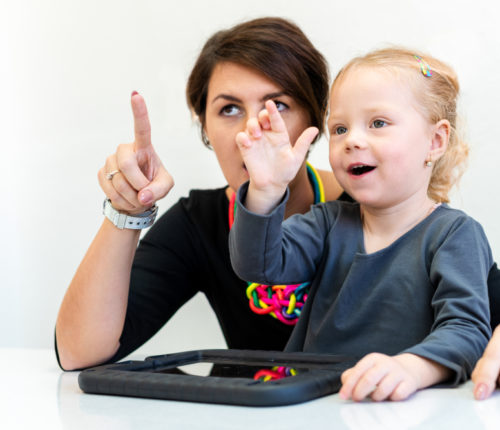
Pediatric Occupational Therapy
Occupational therapy is relevant to babies and children who need assistance with development (cognitive, motor, sensory, communication and play skills), disabilities, disorders and much more. Pediatric occupational therapy is often prescribed for infants who have delayed development in fine motor skills and self-care, and who have difficulties with sensory processing. The ultimate goal of occupational therapy is to allow engagement in meaningful activities, which for an infant/child is play. With adequate therapy, your child may be able to overcome a developmental delay, or see an improvement in a developmental disorder.
The Difference Between Physical Therapy and Occupational Therapy
Pediatric physical therapy and pediatric occupational therapy are similar in the sense that both types of therapies aim to help babies and children live their lives at the highest quality possible. The two disciplines frequently overlap with pediatric treatments. However, physical therapy tends to focus more on the musculoskeletal system to enable the individual to reach his/her maximal mobility. Treatment techniques typically focus on endurance, gross motor function, pain and joint range of motion.
Occupational therapy uses a holistic approach to obtain one’s greatest independence with functional everyday skills like eating, playing and dressing. Occupational therapists also specialize in areas such as sensory-processing, fine motor skills, strength, development and cognitive skills.
Pediatric Occupational Therapy and Birth Injuries
Below are some ways that occupational therapy helps infants and children with birth injuries:
Delays in Fine Motor Skills
There are a variety of characteristics that can hinder a infant’s progress with fine motor skills and development. Some of which include:
- Floppy, poor, and/or limp muscle tone
- High tone
- Hypersensitivity or hyposensitivity
- Lack of motor control and dexterity
Fine motor skills are the coordination of small muscle movements, such as in the fingers, hands and toes. When infants have weak fine motor skills, they may be unable to perform daily “occupational” skills that are age-appropriate, such as holding a bottle while drinking, grasping objects and bringing their hands to their mouth.
Fine motor skills can be delayed for a number of reasons, including premature birth, traumatic birth injuries that lead to neurological disorders, genetic factors, pregnancy complications and general weakness.
A pediatric occupational therapist helps babies with delays in fine motor skills by:
- Helping them learn typical motor movements
- Stimulating toys and positioning equipment
- Helping them bring their hands together via physical development exercises and play.
- Helping with grasping objects via small muscle strength training
- Providing input and stimulation to the affected muscles
- Encouraging typical play behaviors and motor movements
Once babies start to develop and improve their fine motor skills, occupational therapists help them apply their skills to self-care, such as bottle feeding alone, holding spoons, finger feeding and so much more.
Delays in Sensory Processing and Cognitive Skills
Sensory processing, also known as sensory integration, is a medical term that defines the way the nervous system receives and interprets messages. Once the message is sensed, in typical development, an action follows, such as a behavioral response or a motor action.
Infants who display delays in sensory processing can have a difficult time taking in, processing and/or appropriately responding to incoming sensory signals. For instance, a baby who has an injury may not cry as expected – this baby may be hyporesponsive. In other instances, an infant may overreact to the slightest touch – this baby is hyperresponsive. Even the fabric of a soft blanket may be too noxious for a baby with a sensory processing disorder to handle, and they may react with incessant crying. Other babies may cry when around light and/or sounds.
Occupational therapists treat babies with sensory processing delays and disorders by first recognizing and identifying the disorder. They then work with the infant applying various exercise techniques and modalities to help the baby become more comfortable and adapt easier to participate in his/her environment and daily living activities.
For example, if an infant has trouble sleeping through the night due to sound sensitivity, an occupational therapist will create and carry out an individualized plan for desensitization to sounds that helps the baby grow more tolerant to common noises, and therefore improving sleep patterns. If a baby has touch sensitivities (tactile defensiveness), an occupational therapist will work towards promoting decreased touch sensitivity. Depending on the child’s aversions common exercises and activities for this treatment plan may include:
- Relaxing bath time activities, using soaps and gentle massages
- Specialized toys and activities to help babies learn how to deal with sounds, lights, and touch appropriately
- Sand and water therapy
- Joint brushing and joint compressions
- Proprioceptive input activities
- Vestibular input activities
- Feeding therapy
- Olfactory input activities
- Engagement with a variety of textures
Where Does Occupational Therapy Take Place?
Occupational therapy can take place in pediatric hospitals, clinics, healthcare facilities, schools/childcare facilities and specialized centers that focus on infants and occupational therapy. Therapy can also take place in a child’s home.
Parents and loved ones are encouraged to reinforce carryover of activities and exercises with their babies at home as well. In fact, occupational therapists work closely with parents when devising plans and goals and often need parental/caregiver participation for the high chances of stronger participation and optimal outcome.
Pediatric Occupational Therapist Qualifications
Pediatric occupational therapists hold a master’s degree in occupational therapy from an accredited OT program, along with state licensing requirements, which will vary according to each state. The therapist must apply for and pass the certification boards (NBCOT).
In addition, supervised internships (clinicals/fieldwork) are required as well as optional specialty disciples (ex. hand therapist). It is recommended that parents work with someone who specializes in treating infants and is board-certified in pediatric occupational therapy.
For assistance in finding a qualified infant occupational therapist, consult with your baby’s pediatrician.



